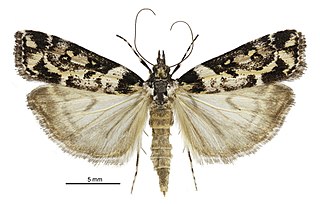
Eudonia diphtheralis is a species of moth in the family Crambidae. It is endemic to New Zealand.
Dichomeris geochrota is a moth in the family Gelechiidae. It was described by Edward Meyrick in 1914. It is found in southern India.
Dichomeris seminata is a moth in the family Gelechiidae. It was described by Edward Meyrick in 1922. It is found on the Seychelles, where it has been recorded from Aldabra.
Helcystogramma meconitis is a moth in the family Gelechiidae. It was described by Edward Meyrick in 1913. It is found in Argentina.
Ephysteris suasoria is a moth in the family Gelechiidae. It was described by Edward Meyrick in 1918. It is found in southern India and Palestine.
Scrobipalpa chersophila is a moth in the family Gelechiidae. It was described by Edward Meyrick in 1909. It is found in South Africa.
Scrobipalpa concreta is a moth in the family Gelechiidae. It was described by Edward Meyrick in 1914. It is found in South Africa and the former Orientale Province of the Democratic Republic of the Congo.
Scrobipalpa incola is a moth in the family Gelechiidae. It was described by Edward Meyrick in 1912. It is found in South Africa and Zimbabwe.
Scrobipalpa pyrrhanthes is a moth in the family Gelechiidae. It was described by Edward Meyrick in 1904. It is found in Australia, where it has been recorded form New South Wales, Western Australia, and Victoria.
Scrobipalpula crustaria is a moth in the family Gelechiidae. It was described by Edward Meyrick in 1917. It is found in Peru.
Symmetrischema loquax is a moth in the family Gelechiidae. It was described by Edward Meyrick in 1917. It is found in Peru.
Epimimastis tegminata is a moth in the family Gelechiidae. It was described by Edward Meyrick in 1916. It is found in Australia, where it has been recorded from Queensland.
Idiophantis paraptila is a moth of the family Gelechiidae. It was described by Edward Meyrick in 1916. It is found in Sri Lanka.
Stomopteryx frivola is a moth of the family Gelechiidae. It was described by Edward Meyrick in 1926. It is found in South Africa.
Photodotis spilodoma is a moth of the family Gelechiidae. It was described by Edward Meyrick in 1918. It is found in South Africa.
Autosticha flavescens is a moth in the family Autostichidae. It was described by Edward Meyrick in 1916. It is found in Sri Lanka.
Orphnolechia acridula is a moth of the family Depressariidae first described by Edward Meyrick in 1918. It is found in French Guiana.
Trichoboscis crocosema is a moth in the family Lecithoceridae. It was described by Edward Meyrick in 1929. It is found in India's Andaman Islands.
Lecithocera macella is a moth in the family Lecithoceridae. It was described by Edward Meyrick in 1918. It is found in southern India.
Imma synconista is a moth in the family Immidae. It was described by Edward Meyrick in 1918. It is found in Kanara, India.
